Business Research Methods: Analyzing Customer Satisfaction Theories
VerifiedAdded on 2021/05/30
|9
|1758
|44
Report
AI Summary
This report delves into the critical concept of customer satisfaction within the business realm, emphasizing its impact on a company's survival and success. It examines customer satisfaction through the lens of reviews, feedback, and survey questionnaires, as well as the role of social media and online marketing. The report analyzes various theories and ideas from research articles, identifying common and distinct themes related to customer satisfaction. These themes include the evolution of customer awareness due to social media, the importance of product quality and perceived value, and the influence of emotions and sensory experiences on customer purchasing decisions. The report also acknowledges study limitations, such as cultural differences and small sample sizes, and proposes directions for future research. Ultimately, the report highlights the significance of customer reviews and feedback in promoting goods and services, the role of quality in ensuring satisfaction, and the use of marketing tools for gathering customer insights.
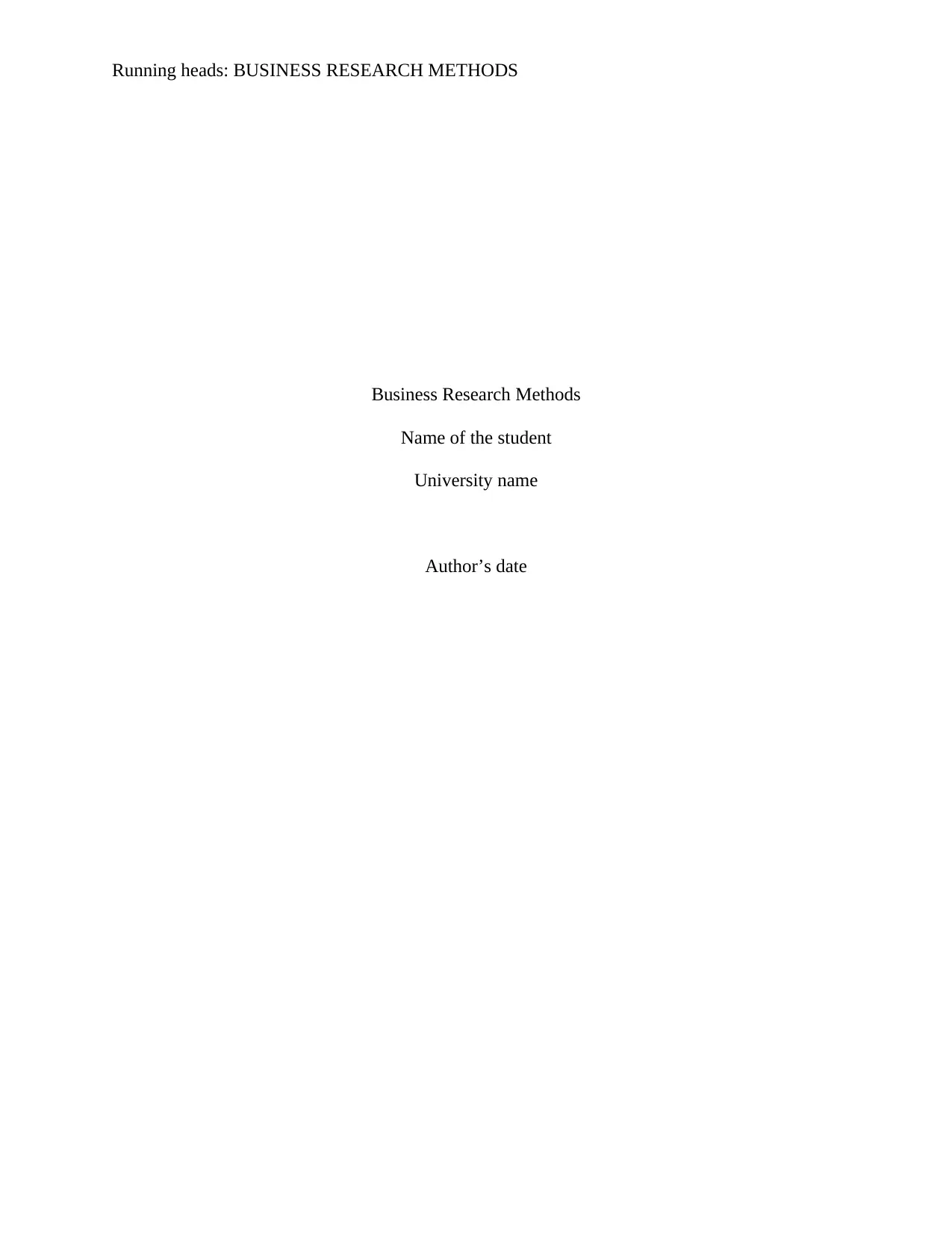
Running heads: BUSINESS RESEARCH METHODS
Business Research Methods
Name of the student
University name
Author’s date
Business Research Methods
Name of the student
University name
Author’s date
Paraphrase This Document
Need a fresh take? Get an instant paraphrase of this document with our AI Paraphraser
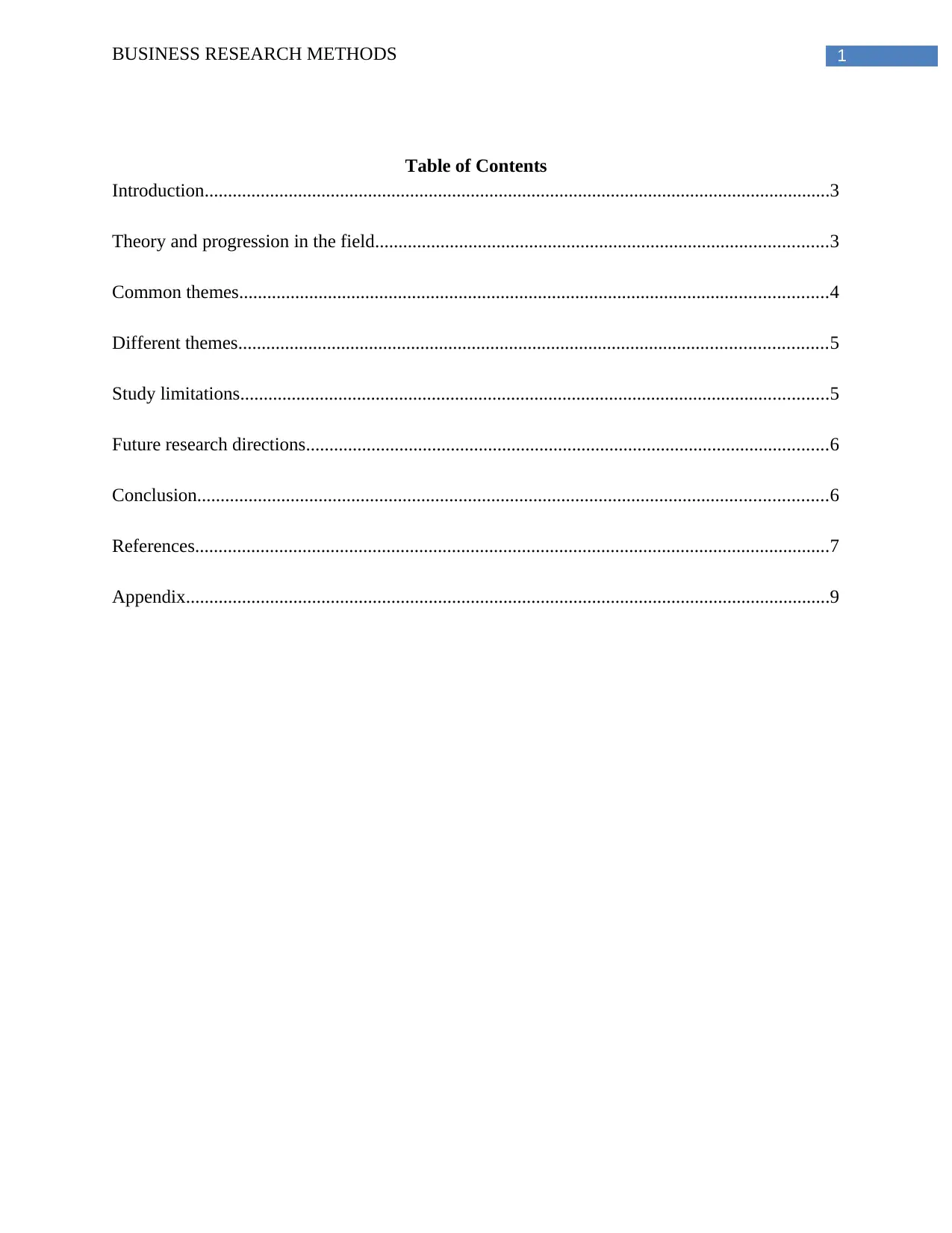
1BUSINESS RESEARCH METHODS
Table of Contents
Introduction......................................................................................................................................3
Theory and progression in the field.................................................................................................3
Common themes..............................................................................................................................4
Different themes..............................................................................................................................5
Study limitations..............................................................................................................................5
Future research directions................................................................................................................6
Conclusion.......................................................................................................................................6
References........................................................................................................................................7
Appendix..........................................................................................................................................9
Table of Contents
Introduction......................................................................................................................................3
Theory and progression in the field.................................................................................................3
Common themes..............................................................................................................................4
Different themes..............................................................................................................................5
Study limitations..............................................................................................................................5
Future research directions................................................................................................................6
Conclusion.......................................................................................................................................6
References........................................................................................................................................7
Appendix..........................................................................................................................................9
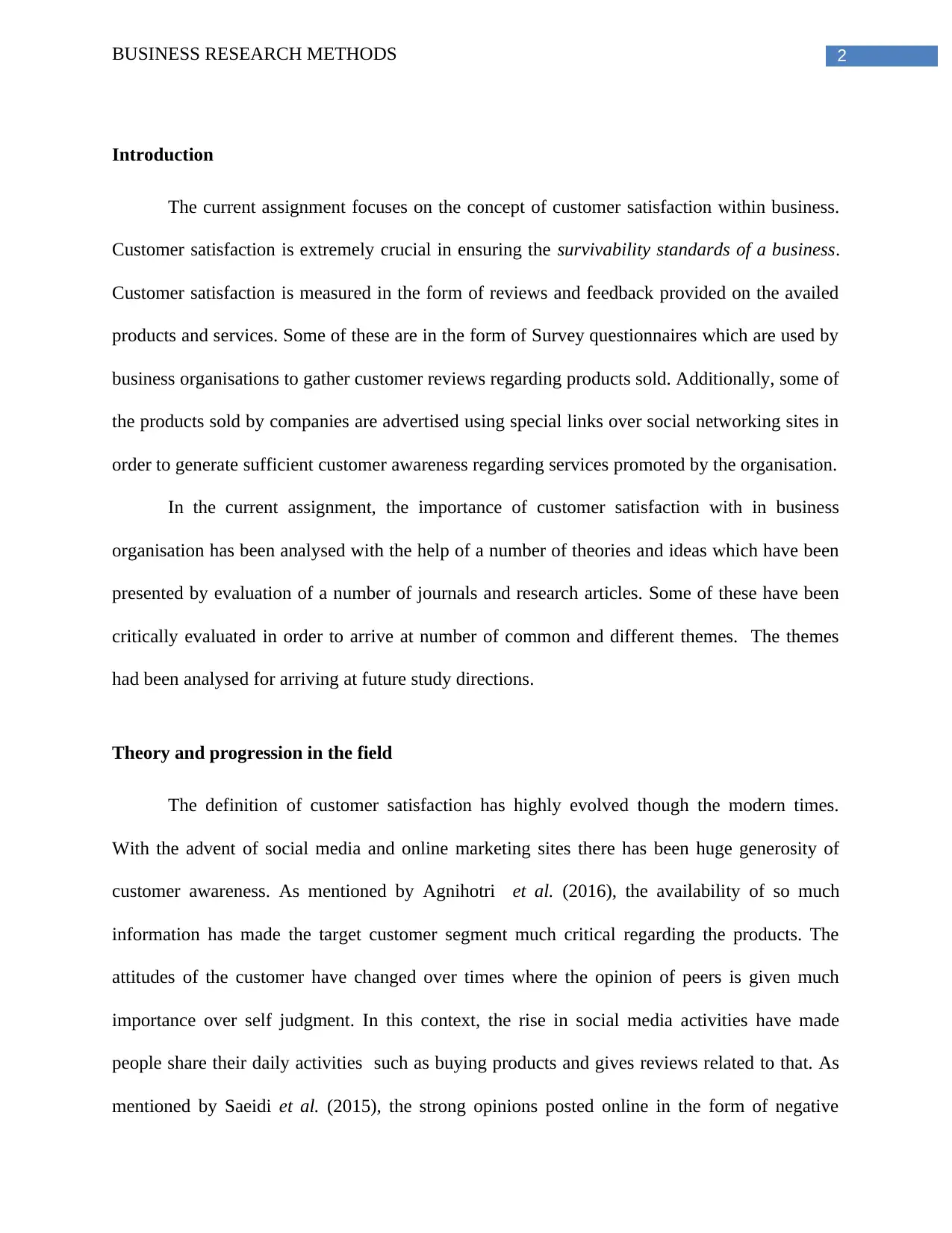
2BUSINESS RESEARCH METHODS
Introduction
The current assignment focuses on the concept of customer satisfaction within business.
Customer satisfaction is extremely crucial in ensuring the survivability standards of a business.
Customer satisfaction is measured in the form of reviews and feedback provided on the availed
products and services. Some of these are in the form of Survey questionnaires which are used by
business organisations to gather customer reviews regarding products sold. Additionally, some of
the products sold by companies are advertised using special links over social networking sites in
order to generate sufficient customer awareness regarding services promoted by the organisation.
In the current assignment, the importance of customer satisfaction with in business
organisation has been analysed with the help of a number of theories and ideas which have been
presented by evaluation of a number of journals and research articles. Some of these have been
critically evaluated in order to arrive at number of common and different themes. The themes
had been analysed for arriving at future study directions.
Theory and progression in the field
The definition of customer satisfaction has highly evolved though the modern times.
With the advent of social media and online marketing sites there has been huge generosity of
customer awareness. As mentioned by Agnihotri et al. (2016), the availability of so much
information has made the target customer segment much critical regarding the products. The
attitudes of the customer have changed over times where the opinion of peers is given much
importance over self judgment. In this context, the rise in social media activities have made
people share their daily activities such as buying products and gives reviews related to that. As
mentioned by Saeidi et al. (2015), the strong opinions posted online in the form of negative
Introduction
The current assignment focuses on the concept of customer satisfaction within business.
Customer satisfaction is extremely crucial in ensuring the survivability standards of a business.
Customer satisfaction is measured in the form of reviews and feedback provided on the availed
products and services. Some of these are in the form of Survey questionnaires which are used by
business organisations to gather customer reviews regarding products sold. Additionally, some of
the products sold by companies are advertised using special links over social networking sites in
order to generate sufficient customer awareness regarding services promoted by the organisation.
In the current assignment, the importance of customer satisfaction with in business
organisation has been analysed with the help of a number of theories and ideas which have been
presented by evaluation of a number of journals and research articles. Some of these have been
critically evaluated in order to arrive at number of common and different themes. The themes
had been analysed for arriving at future study directions.
Theory and progression in the field
The definition of customer satisfaction has highly evolved though the modern times.
With the advent of social media and online marketing sites there has been huge generosity of
customer awareness. As mentioned by Agnihotri et al. (2016), the availability of so much
information has made the target customer segment much critical regarding the products. The
attitudes of the customer have changed over times where the opinion of peers is given much
importance over self judgment. In this context, the rise in social media activities have made
people share their daily activities such as buying products and gives reviews related to that. As
mentioned by Saeidi et al. (2015), the strong opinions posted online in the form of negative
⊘ This is a preview!⊘
Do you want full access?
Subscribe today to unlock all pages.

Trusted by 1+ million students worldwide
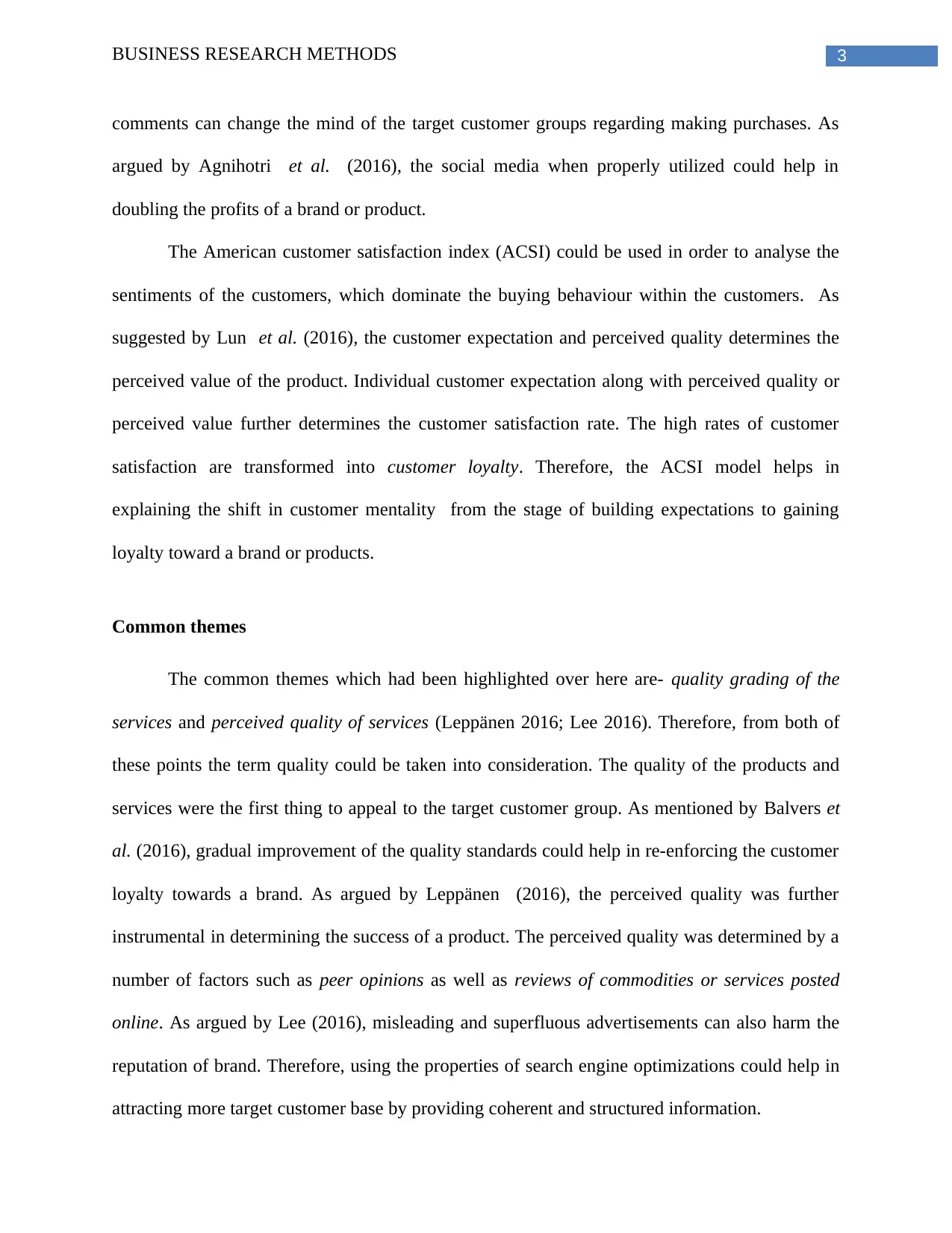
3BUSINESS RESEARCH METHODS
comments can change the mind of the target customer groups regarding making purchases. As
argued by Agnihotri et al. (2016), the social media when properly utilized could help in
doubling the profits of a brand or product.
The American customer satisfaction index (ACSI) could be used in order to analyse the
sentiments of the customers, which dominate the buying behaviour within the customers. As
suggested by Lun et al. (2016), the customer expectation and perceived quality determines the
perceived value of the product. Individual customer expectation along with perceived quality or
perceived value further determines the customer satisfaction rate. The high rates of customer
satisfaction are transformed into customer loyalty. Therefore, the ACSI model helps in
explaining the shift in customer mentality from the stage of building expectations to gaining
loyalty toward a brand or products.
Common themes
The common themes which had been highlighted over here are- quality grading of the
services and perceived quality of services (Leppänen 2016; Lee 2016). Therefore, from both of
these points the term quality could be taken into consideration. The quality of the products and
services were the first thing to appeal to the target customer group. As mentioned by Balvers et
al. (2016), gradual improvement of the quality standards could help in re-enforcing the customer
loyalty towards a brand. As argued by Leppänen (2016), the perceived quality was further
instrumental in determining the success of a product. The perceived quality was determined by a
number of factors such as peer opinions as well as reviews of commodities or services posted
online. As argued by Lee (2016), misleading and superfluous advertisements can also harm the
reputation of brand. Therefore, using the properties of search engine optimizations could help in
attracting more target customer base by providing coherent and structured information.
comments can change the mind of the target customer groups regarding making purchases. As
argued by Agnihotri et al. (2016), the social media when properly utilized could help in
doubling the profits of a brand or product.
The American customer satisfaction index (ACSI) could be used in order to analyse the
sentiments of the customers, which dominate the buying behaviour within the customers. As
suggested by Lun et al. (2016), the customer expectation and perceived quality determines the
perceived value of the product. Individual customer expectation along with perceived quality or
perceived value further determines the customer satisfaction rate. The high rates of customer
satisfaction are transformed into customer loyalty. Therefore, the ACSI model helps in
explaining the shift in customer mentality from the stage of building expectations to gaining
loyalty toward a brand or products.
Common themes
The common themes which had been highlighted over here are- quality grading of the
services and perceived quality of services (Leppänen 2016; Lee 2016). Therefore, from both of
these points the term quality could be taken into consideration. The quality of the products and
services were the first thing to appeal to the target customer group. As mentioned by Balvers et
al. (2016), gradual improvement of the quality standards could help in re-enforcing the customer
loyalty towards a brand. As argued by Leppänen (2016), the perceived quality was further
instrumental in determining the success of a product. The perceived quality was determined by a
number of factors such as peer opinions as well as reviews of commodities or services posted
online. As argued by Lee (2016), misleading and superfluous advertisements can also harm the
reputation of brand. Therefore, using the properties of search engine optimizations could help in
attracting more target customer base by providing coherent and structured information.
Paraphrase This Document
Need a fresh take? Get an instant paraphrase of this document with our AI Paraphraser
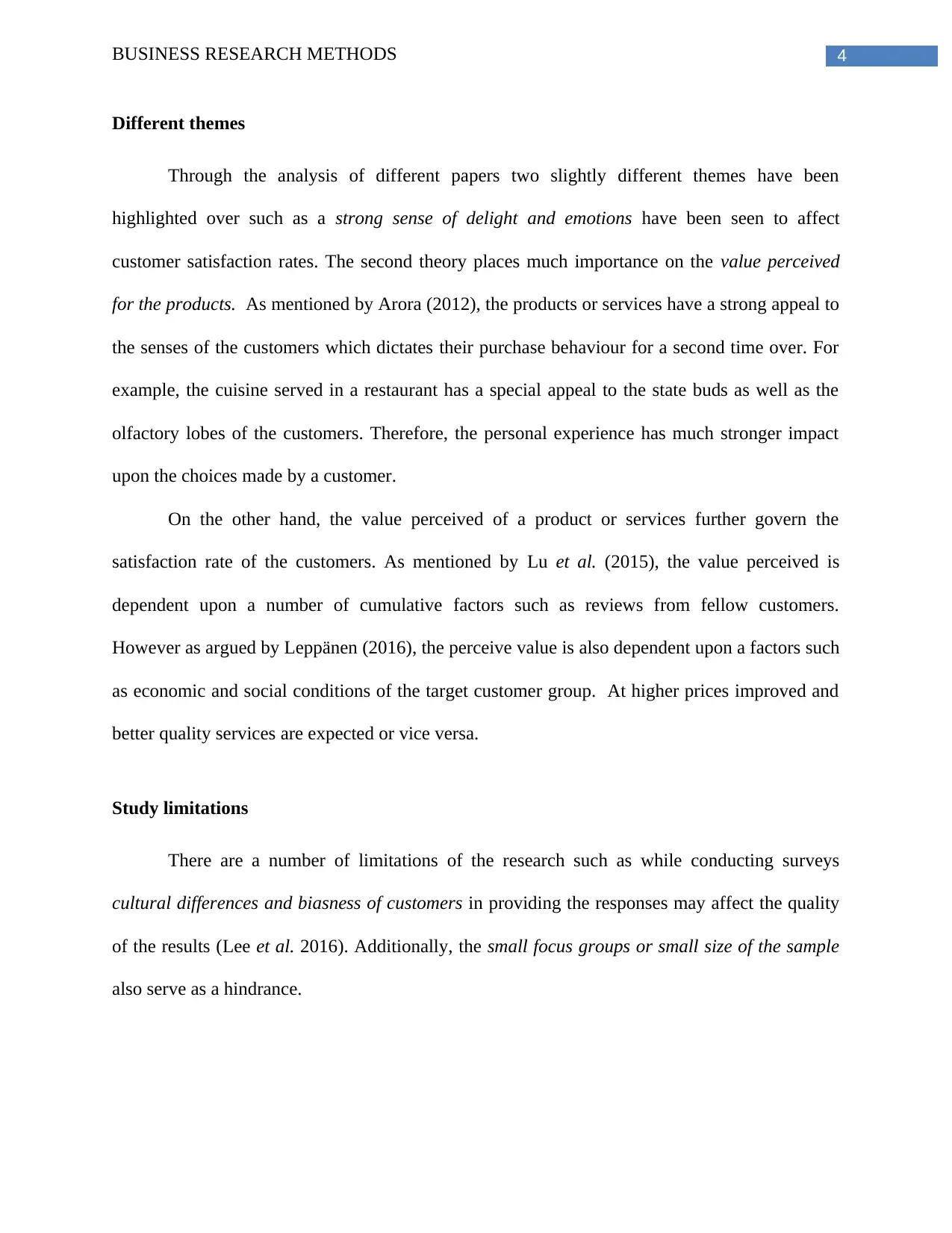
4BUSINESS RESEARCH METHODS
Different themes
Through the analysis of different papers two slightly different themes have been
highlighted over such as a strong sense of delight and emotions have been seen to affect
customer satisfaction rates. The second theory places much importance on the value perceived
for the products. As mentioned by Arora (2012), the products or services have a strong appeal to
the senses of the customers which dictates their purchase behaviour for a second time over. For
example, the cuisine served in a restaurant has a special appeal to the state buds as well as the
olfactory lobes of the customers. Therefore, the personal experience has much stronger impact
upon the choices made by a customer.
On the other hand, the value perceived of a product or services further govern the
satisfaction rate of the customers. As mentioned by Lu et al. (2015), the value perceived is
dependent upon a number of cumulative factors such as reviews from fellow customers.
However as argued by Leppänen (2016), the perceive value is also dependent upon a factors such
as economic and social conditions of the target customer group. At higher prices improved and
better quality services are expected or vice versa.
Study limitations
There are a number of limitations of the research such as while conducting surveys
cultural differences and biasness of customers in providing the responses may affect the quality
of the results (Lee et al. 2016). Additionally, the small focus groups or small size of the sample
also serve as a hindrance.
Different themes
Through the analysis of different papers two slightly different themes have been
highlighted over such as a strong sense of delight and emotions have been seen to affect
customer satisfaction rates. The second theory places much importance on the value perceived
for the products. As mentioned by Arora (2012), the products or services have a strong appeal to
the senses of the customers which dictates their purchase behaviour for a second time over. For
example, the cuisine served in a restaurant has a special appeal to the state buds as well as the
olfactory lobes of the customers. Therefore, the personal experience has much stronger impact
upon the choices made by a customer.
On the other hand, the value perceived of a product or services further govern the
satisfaction rate of the customers. As mentioned by Lu et al. (2015), the value perceived is
dependent upon a number of cumulative factors such as reviews from fellow customers.
However as argued by Leppänen (2016), the perceive value is also dependent upon a factors such
as economic and social conditions of the target customer group. At higher prices improved and
better quality services are expected or vice versa.
Study limitations
There are a number of limitations of the research such as while conducting surveys
cultural differences and biasness of customers in providing the responses may affect the quality
of the results (Lee et al. 2016). Additionally, the small focus groups or small size of the sample
also serve as a hindrance.
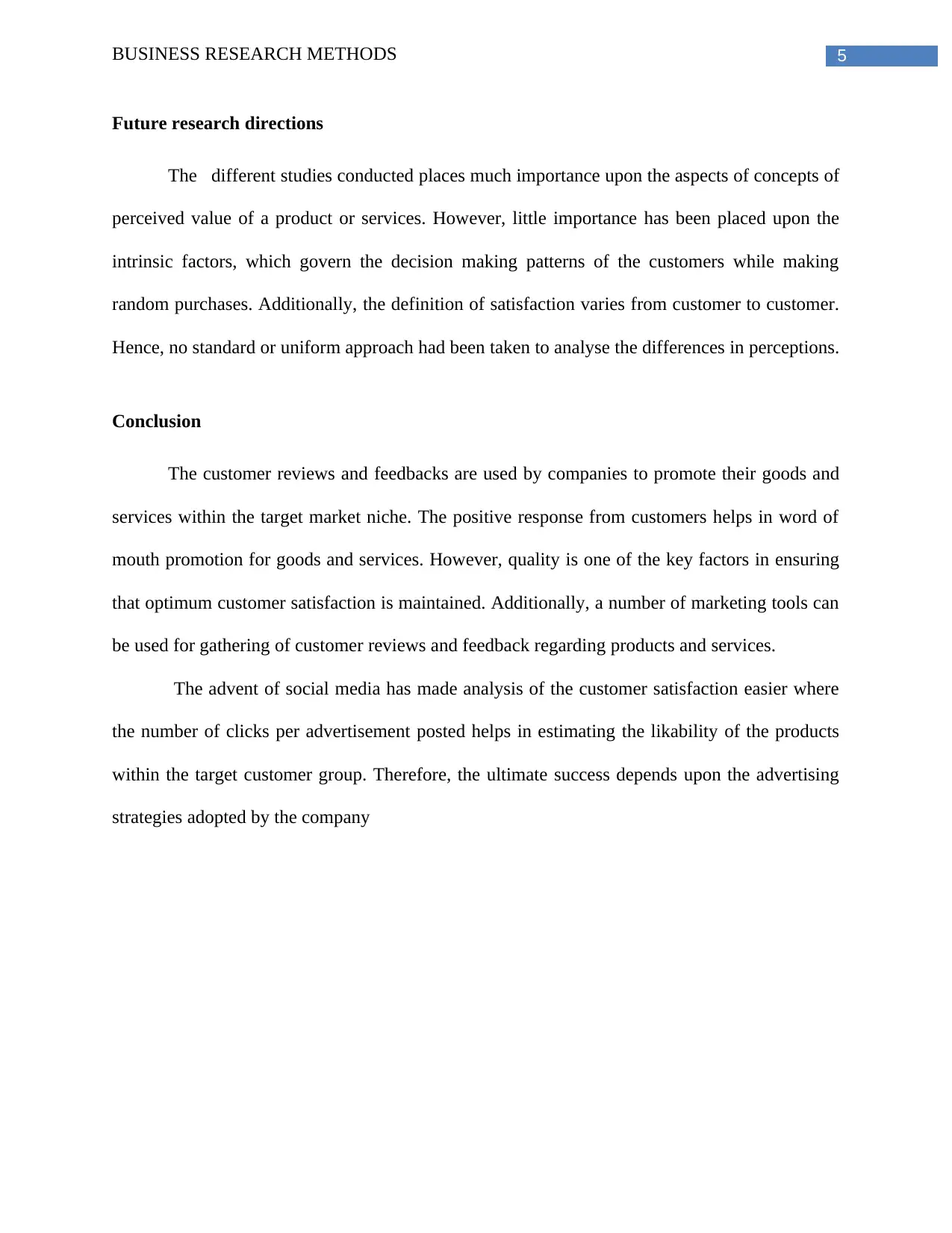
5BUSINESS RESEARCH METHODS
Future research directions
The different studies conducted places much importance upon the aspects of concepts of
perceived value of a product or services. However, little importance has been placed upon the
intrinsic factors, which govern the decision making patterns of the customers while making
random purchases. Additionally, the definition of satisfaction varies from customer to customer.
Hence, no standard or uniform approach had been taken to analyse the differences in perceptions.
Conclusion
The customer reviews and feedbacks are used by companies to promote their goods and
services within the target market niche. The positive response from customers helps in word of
mouth promotion for goods and services. However, quality is one of the key factors in ensuring
that optimum customer satisfaction is maintained. Additionally, a number of marketing tools can
be used for gathering of customer reviews and feedback regarding products and services.
The advent of social media has made analysis of the customer satisfaction easier where
the number of clicks per advertisement posted helps in estimating the likability of the products
within the target customer group. Therefore, the ultimate success depends upon the advertising
strategies adopted by the company
Future research directions
The different studies conducted places much importance upon the aspects of concepts of
perceived value of a product or services. However, little importance has been placed upon the
intrinsic factors, which govern the decision making patterns of the customers while making
random purchases. Additionally, the definition of satisfaction varies from customer to customer.
Hence, no standard or uniform approach had been taken to analyse the differences in perceptions.
Conclusion
The customer reviews and feedbacks are used by companies to promote their goods and
services within the target market niche. The positive response from customers helps in word of
mouth promotion for goods and services. However, quality is one of the key factors in ensuring
that optimum customer satisfaction is maintained. Additionally, a number of marketing tools can
be used for gathering of customer reviews and feedback regarding products and services.
The advent of social media has made analysis of the customer satisfaction easier where
the number of clicks per advertisement posted helps in estimating the likability of the products
within the target customer group. Therefore, the ultimate success depends upon the advertising
strategies adopted by the company
⊘ This is a preview!⊘
Do you want full access?
Subscribe today to unlock all pages.

Trusted by 1+ million students worldwide
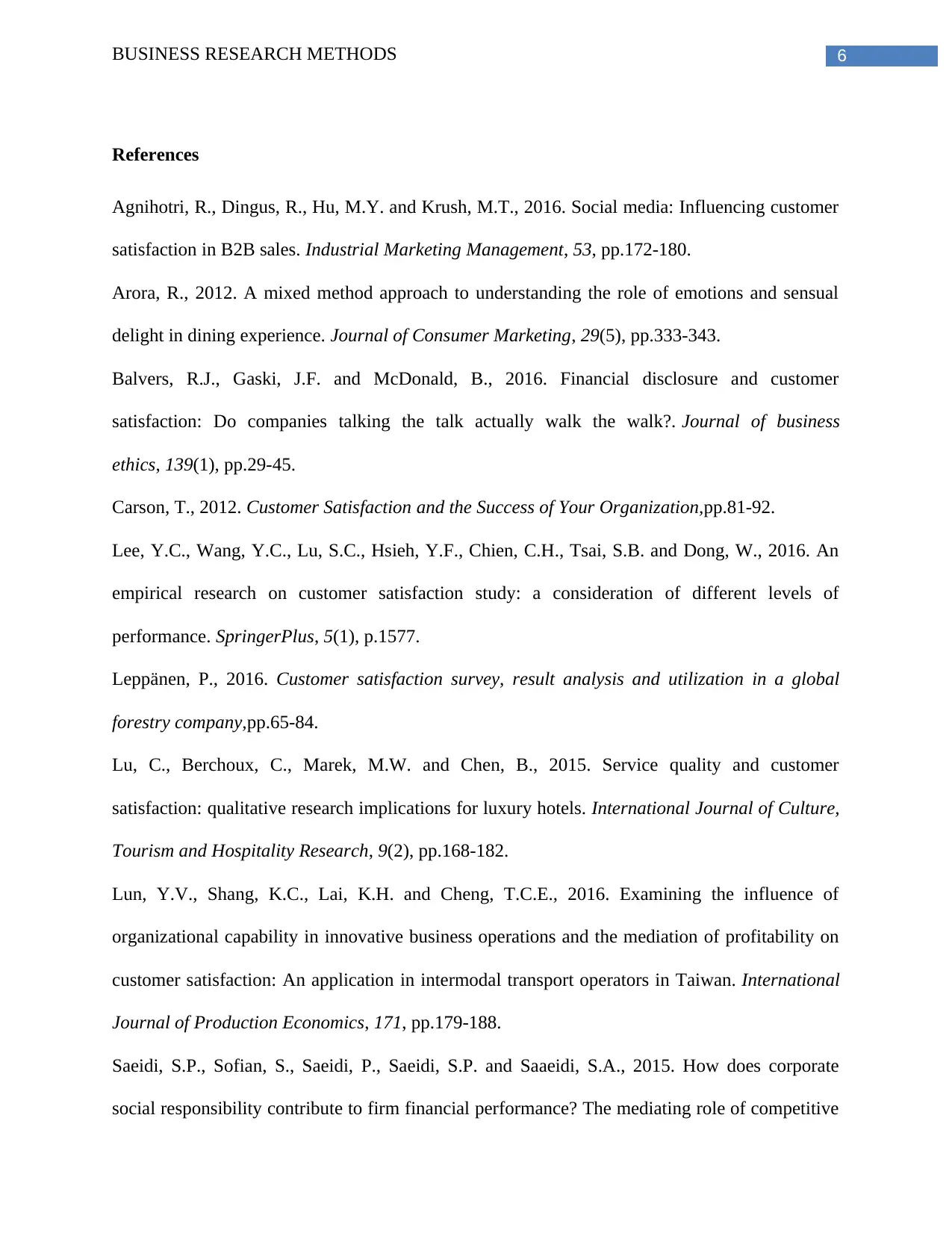
6BUSINESS RESEARCH METHODS
References
Agnihotri, R., Dingus, R., Hu, M.Y. and Krush, M.T., 2016. Social media: Influencing customer
satisfaction in B2B sales. Industrial Marketing Management, 53, pp.172-180.
Arora, R., 2012. A mixed method approach to understanding the role of emotions and sensual
delight in dining experience. Journal of Consumer Marketing, 29(5), pp.333-343.
Balvers, R.J., Gaski, J.F. and McDonald, B., 2016. Financial disclosure and customer
satisfaction: Do companies talking the talk actually walk the walk?. Journal of business
ethics, 139(1), pp.29-45.
Carson, T., 2012. Customer Satisfaction and the Success of Your Organization,pp.81-92.
Lee, Y.C., Wang, Y.C., Lu, S.C., Hsieh, Y.F., Chien, C.H., Tsai, S.B. and Dong, W., 2016. An
empirical research on customer satisfaction study: a consideration of different levels of
performance. SpringerPlus, 5(1), p.1577.
Leppänen, P., 2016. Customer satisfaction survey, result analysis and utilization in a global
forestry company,pp.65-84.
Lu, C., Berchoux, C., Marek, M.W. and Chen, B., 2015. Service quality and customer
satisfaction: qualitative research implications for luxury hotels. International Journal of Culture,
Tourism and Hospitality Research, 9(2), pp.168-182.
Lun, Y.V., Shang, K.C., Lai, K.H. and Cheng, T.C.E., 2016. Examining the influence of
organizational capability in innovative business operations and the mediation of profitability on
customer satisfaction: An application in intermodal transport operators in Taiwan. International
Journal of Production Economics, 171, pp.179-188.
Saeidi, S.P., Sofian, S., Saeidi, P., Saeidi, S.P. and Saaeidi, S.A., 2015. How does corporate
social responsibility contribute to firm financial performance? The mediating role of competitive
References
Agnihotri, R., Dingus, R., Hu, M.Y. and Krush, M.T., 2016. Social media: Influencing customer
satisfaction in B2B sales. Industrial Marketing Management, 53, pp.172-180.
Arora, R., 2012. A mixed method approach to understanding the role of emotions and sensual
delight in dining experience. Journal of Consumer Marketing, 29(5), pp.333-343.
Balvers, R.J., Gaski, J.F. and McDonald, B., 2016. Financial disclosure and customer
satisfaction: Do companies talking the talk actually walk the walk?. Journal of business
ethics, 139(1), pp.29-45.
Carson, T., 2012. Customer Satisfaction and the Success of Your Organization,pp.81-92.
Lee, Y.C., Wang, Y.C., Lu, S.C., Hsieh, Y.F., Chien, C.H., Tsai, S.B. and Dong, W., 2016. An
empirical research on customer satisfaction study: a consideration of different levels of
performance. SpringerPlus, 5(1), p.1577.
Leppänen, P., 2016. Customer satisfaction survey, result analysis and utilization in a global
forestry company,pp.65-84.
Lu, C., Berchoux, C., Marek, M.W. and Chen, B., 2015. Service quality and customer
satisfaction: qualitative research implications for luxury hotels. International Journal of Culture,
Tourism and Hospitality Research, 9(2), pp.168-182.
Lun, Y.V., Shang, K.C., Lai, K.H. and Cheng, T.C.E., 2016. Examining the influence of
organizational capability in innovative business operations and the mediation of profitability on
customer satisfaction: An application in intermodal transport operators in Taiwan. International
Journal of Production Economics, 171, pp.179-188.
Saeidi, S.P., Sofian, S., Saeidi, P., Saeidi, S.P. and Saaeidi, S.A., 2015. How does corporate
social responsibility contribute to firm financial performance? The mediating role of competitive
Paraphrase This Document
Need a fresh take? Get an instant paraphrase of this document with our AI Paraphraser

7BUSINESS RESEARCH METHODS
advantage, reputation, and customer satisfaction. Journal of Business Research, 68(2), pp.341-
350.
advantage, reputation, and customer satisfaction. Journal of Business Research, 68(2), pp.341-
350.
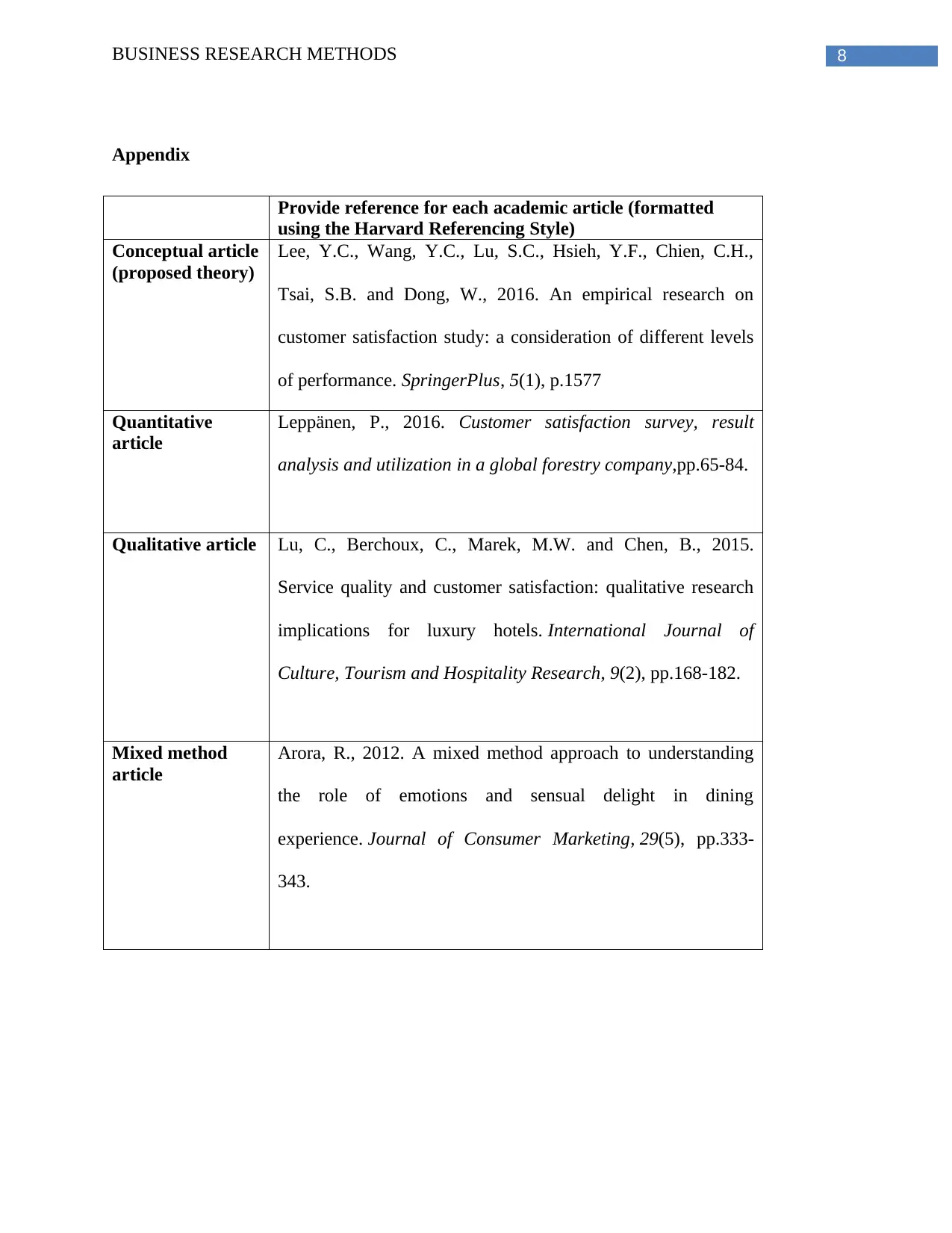
8BUSINESS RESEARCH METHODS
Appendix
Provide reference for each academic article (formatted
using the Harvard Referencing Style)
Conceptual article
(proposed theory)
Lee, Y.C., Wang, Y.C., Lu, S.C., Hsieh, Y.F., Chien, C.H.,
Tsai, S.B. and Dong, W., 2016. An empirical research on
customer satisfaction study: a consideration of different levels
of performance. SpringerPlus, 5(1), p.1577
Quantitative
article
Leppänen, P., 2016. Customer satisfaction survey, result
analysis and utilization in a global forestry company,pp.65-84.
Qualitative article Lu, C., Berchoux, C., Marek, M.W. and Chen, B., 2015.
Service quality and customer satisfaction: qualitative research
implications for luxury hotels. International Journal of
Culture, Tourism and Hospitality Research, 9(2), pp.168-182.
Mixed method
article
Arora, R., 2012. A mixed method approach to understanding
the role of emotions and sensual delight in dining
experience. Journal of Consumer Marketing, 29(5), pp.333-
343.
Appendix
Provide reference for each academic article (formatted
using the Harvard Referencing Style)
Conceptual article
(proposed theory)
Lee, Y.C., Wang, Y.C., Lu, S.C., Hsieh, Y.F., Chien, C.H.,
Tsai, S.B. and Dong, W., 2016. An empirical research on
customer satisfaction study: a consideration of different levels
of performance. SpringerPlus, 5(1), p.1577
Quantitative
article
Leppänen, P., 2016. Customer satisfaction survey, result
analysis and utilization in a global forestry company,pp.65-84.
Qualitative article Lu, C., Berchoux, C., Marek, M.W. and Chen, B., 2015.
Service quality and customer satisfaction: qualitative research
implications for luxury hotels. International Journal of
Culture, Tourism and Hospitality Research, 9(2), pp.168-182.
Mixed method
article
Arora, R., 2012. A mixed method approach to understanding
the role of emotions and sensual delight in dining
experience. Journal of Consumer Marketing, 29(5), pp.333-
343.
⊘ This is a preview!⊘
Do you want full access?
Subscribe today to unlock all pages.

Trusted by 1+ million students worldwide
1 out of 9
Related Documents
Your All-in-One AI-Powered Toolkit for Academic Success.
+13062052269
info@desklib.com
Available 24*7 on WhatsApp / Email
![[object Object]](/_next/static/media/star-bottom.7253800d.svg)
Unlock your academic potential
Copyright © 2020–2025 A2Z Services. All Rights Reserved. Developed and managed by ZUCOL.





